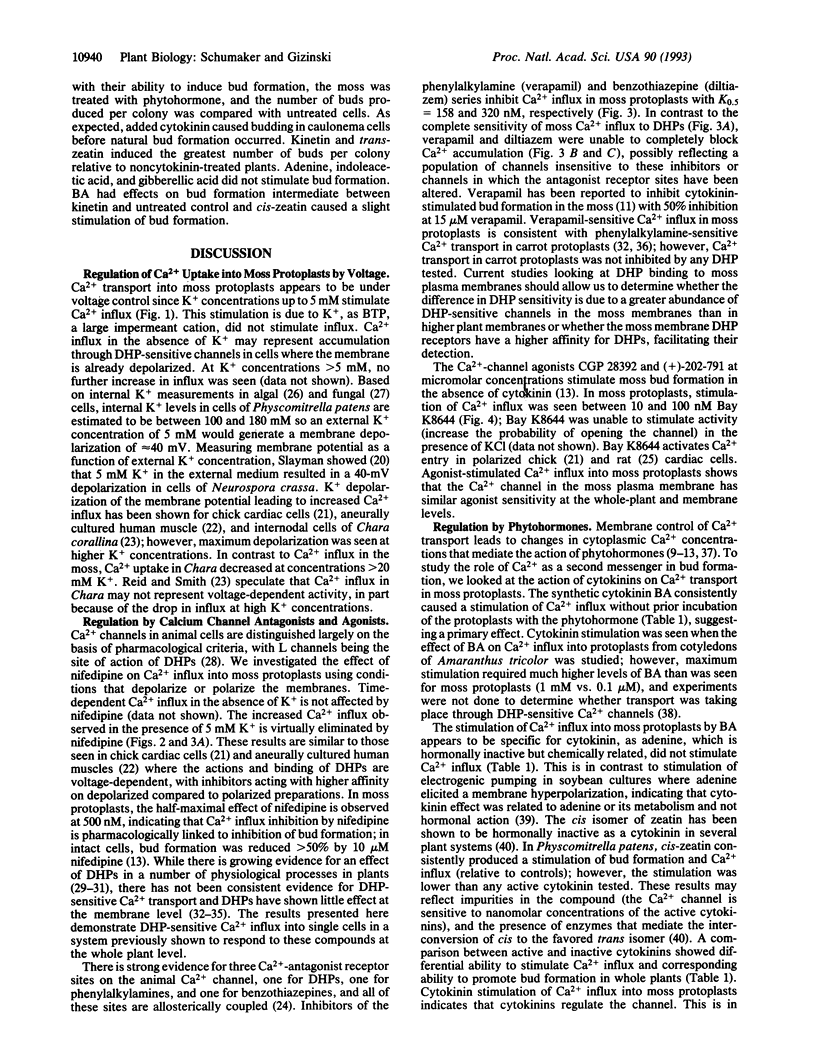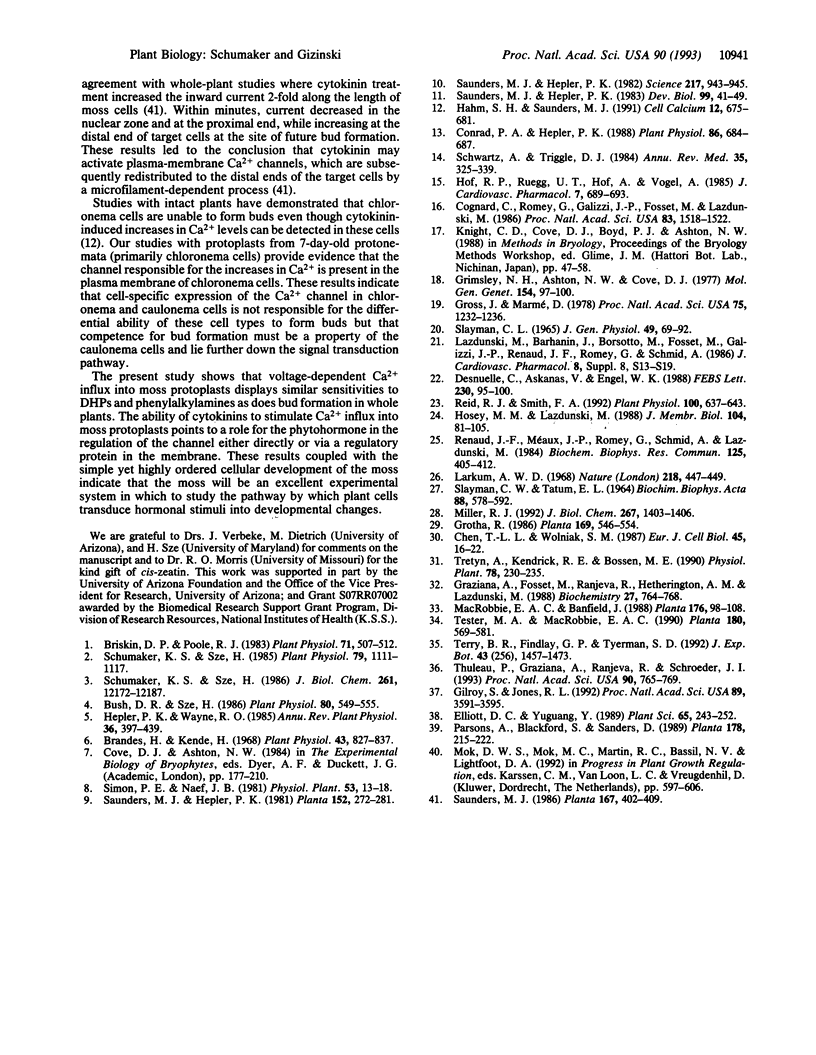Abstract
Ca2+ influx through dihydropyridine (DHP)-sensitive Ca2+ channels is thought to be an early event in cytokinin-induced bud formation in moss protonema because DHP antagonists inhibit bud formation in the presence of cytokinin and DHP agonists stimulate bud formation in the absence of cytokinin [Conrad, P. A. & Helper, P. K. (1988) Plant Physiol. 86, 684-687]. In the present study, we established the presence of a DHP-sensitive Ca2+ transport system by measuring 45Ca2+ influx into moss protoplasts. Ca2+ influx was stimulated by external KCl (up to 5 mM), indicating that transport is voltage-dependent. K(+)-induced Ca2+ influx was DHP-sensitive with > 50% inhibition at 500 nM nifedipine. Ca2+ influx was stimulated by increasing concentrations of the DHP Ca2+ channel agonist Bay K8644 with half-maximal effects at 25 nM; this stimulation was seen only in the absence of K+, suggesting that the agonist works preferentially on polarized membranes. Ca2+ influx was also inhibited by phenylalkylamines (verapamil) and benzothiazepines (diltiazem). The phytohormone 6-benzylaminopurine consistently stimulated Ca2+ influx with a Km value of 1 nM, whereas adenine, indoleacetic acid, and gibberellic acid had no effect on Ca2+ transport. The cytokinins kinetin and trans-zeatin caused a greater stimulation of Ca2+ influx and induced more bud formation than did 6-benzylaminopurine. These results indicate that Ca2+ is taken up into moss protoplasts through voltage-dependent DHP-sensitive Ca2+ channels on the plasma membrane and that one of the cytokinin effects in the induction of bud formation is regulation of this plasma membrane Ca2+ channel.
Full text
PDF




Selected References
These references are in PubMed. This may not be the complete list of references from this article.
- Brandes H., Kende H. Studies on cytokinin-controlled bud formation in moss protonemata. Plant Physiol. 1968 May;43(5):827–837. doi: 10.1104/pp.43.5.827. [DOI] [PMC free article] [PubMed] [Google Scholar]
- Briskin D. P., Poole R. J. Plasma membrane ATPase of red beet forms a phosphorylated intermediate. Plant Physiol. 1983 Mar;71(3):507–512. doi: 10.1104/pp.71.3.507. [DOI] [PMC free article] [PubMed] [Google Scholar]
- Bush D. R., Sze H. Calcium transport in tonoplast and endoplasmic reticulum vesicles isolated from cultured carrot cells. Plant Physiol. 1986 Feb;80(2):549–555. doi: 10.1104/pp.80.2.549. [DOI] [PMC free article] [PubMed] [Google Scholar]
- Chen T. L., Wolniak S. M. Mitotic progression in stamen hair cells of Tradescantia is accelerated by treatment with ruthenium red and Bay K-8644. Eur J Cell Biol. 1987 Dec;45(1):16–22. [PubMed] [Google Scholar]
- Cognard C., Romey G., Galizzi J. P., Fosset M., Lazdunski M. Dihydropyridine-sensitive Ca2+ channels in mammalian skeletal muscle cells in culture: electrophysiological properties and interactions with Ca2+ channel activator (Bay K8644) and inhibitor (PN 200-110). Proc Natl Acad Sci U S A. 1986 Mar;83(5):1518–1522. doi: 10.1073/pnas.83.5.1518. [DOI] [PMC free article] [PubMed] [Google Scholar]
- Conrad P. A., Hepler P. K. The effect of 1,4-dihydropyridines on the initiation and development of gametophore buds in the moss funaria. Plant Physiol. 1988 Mar;86(3):684–687. doi: 10.1104/pp.86.3.684. [DOI] [PMC free article] [PubMed] [Google Scholar]
- Desnuelle C., Askanas V., Engel W. K. Dihydropyridine-sensitive Ca2+ channel in aneurally cultured human muscles. Relationship between high-affinity binding site and inhibition of calcium uptake. FEBS Lett. 1988 Mar 28;230(1-2):95–100. doi: 10.1016/0014-5793(88)80649-5. [DOI] [PubMed] [Google Scholar]
- Gilroy S., Jones R. L. Gibberellic acid and abscisic acid coordinately regulate cytoplasmic calcium and secretory activity in barley aleurone protoplasts. Proc Natl Acad Sci U S A. 1992 Apr 15;89(8):3591–3595. doi: 10.1073/pnas.89.8.3591. [DOI] [PMC free article] [PubMed] [Google Scholar]
- Gross J., Marmé D. ATP-dependent Ca uptake into plant membrane vesicles. Proc Natl Acad Sci U S A. 1978 Mar;75(3):1232–1236. doi: 10.1073/pnas.75.3.1232. [DOI] [PMC free article] [PubMed] [Google Scholar]
- Hahm S. H., Saunders M. J. Cytokinin increases intracellular Ca2+ in Funaria: detection with Indo-1. Cell Calcium. 1991 Nov;12(10):675–681. doi: 10.1016/0143-4160(91)90037-f. [DOI] [PubMed] [Google Scholar]
- Hof R. P., Rüegg U. T., Hof A., Vogel A. Stereoselectivity at the calcium channel: opposite action of the enantiomers of a 1,4-dihydropyridine. J Cardiovasc Pharmacol. 1985 Jul-Aug;7(4):689–693. doi: 10.1097/00005344-198507000-00012. [DOI] [PubMed] [Google Scholar]
- Hosey M. M., Lazdunski M. Calcium channels: molecular pharmacology, structure and regulation. J Membr Biol. 1988 Sep;104(2):81–105. doi: 10.1007/BF01870922. [DOI] [PubMed] [Google Scholar]
- Lazdunski M., Barhanin J., Borsotto M., Fosset M., Galizzi J. P., Renaud J. F., Romey G., Schmid A. Dihydropyridine-sensitive Ca2+ channels: molecular properties of interaction with Ca2+ channel blockers, purification, subunit structure, and differentiation. J Cardiovasc Pharmacol. 1986;8 (Suppl 8):S13–S19. [PubMed] [Google Scholar]
- Miller R. J. Voltage-sensitive Ca2+ channels. J Biol Chem. 1992 Jan 25;267(3):1403–1406. [PubMed] [Google Scholar]
- Reid R. J., Smith F. A. Regulation of Calcium Influx in Chara: Effects of K, pH, Metabolic Inhibition, and Calcium Channel Blockers. Plant Physiol. 1992 Oct;100(2):637–643. doi: 10.1104/pp.100.2.637. [DOI] [PMC free article] [PubMed] [Google Scholar]
- Renaud J. F., Méaux J. P., Romey G., Schmid A., Lazdunski M. Activation of the voltage-dependent Ca2+ channel in rat heart cells by dihydropyridine derivatives. Biochem Biophys Res Commun. 1984 Nov 30;125(1):405–412. doi: 10.1016/s0006-291x(84)80382-4. [DOI] [PubMed] [Google Scholar]
- SLAYMAN C. W., TATUM E. L. POTASSIUM TRANSPORT IN NEUROSPORA. I. INTRACELLULAR SODIUM AND POTASSIUM CONCENTRATIONS, AND CATION REQUIREMENTS FOR GROWTH. Biochim Biophys Acta. 1964 Nov 29;88:578–592. [PubMed] [Google Scholar]
- Saunders M. J., Hepler P. K. Calcium antagonists and calmodulin inhibitors block cytokinin-induced bud formation in Funaria. Dev Biol. 1983 Sep;99(1):41–49. doi: 10.1016/0012-1606(83)90252-x. [DOI] [PubMed] [Google Scholar]
- Saunders M. J., Hepler P. K. Calcium ionophore a23187 stimulates cytokinin-like mitosis in funaria. Science. 1982 Sep 3;217(4563):943–945. doi: 10.1126/science.217.4563.943. [DOI] [PubMed] [Google Scholar]
- Schumaker K. S., Sze H. A Ca/H Antiport System Driven by the Proton Electrochemical Gradient of a Tonoplast H-ATPase from Oat Roots. Plant Physiol. 1985 Dec;79(4):1111–1117. doi: 10.1104/pp.79.4.1111. [DOI] [PMC free article] [PubMed] [Google Scholar]
- Schumaker K. S., Sze H. Calcium transport into the vacuole of oat roots. Characterization of H+/Ca2+ exchange activity. J Biol Chem. 1986 Sep 15;261(26):12172–12178. [PubMed] [Google Scholar]
- Schwartz A., Triggle D. J. Cellular action of calcium channel blocking drugs. Annu Rev Med. 1984;35:325–339. doi: 10.1146/annurev.me.35.020184.001545. [DOI] [PubMed] [Google Scholar]
- Slayman C. L. Electrical properties of Neurospora crassa. Effects of external cations on the intracellular potential. J Gen Physiol. 1965 Sep;49(1):69–92. doi: 10.1085/jgp.49.1.69. [DOI] [PMC free article] [PubMed] [Google Scholar]
- Thuleau P., Graziana A., Ranjeva R., Schroeder J. I. Solubilized proteins from carrot (Daucus carota L.) membranes bind calcium channel blockers and form calcium-permeable ion channels. Proc Natl Acad Sci U S A. 1993 Jan 15;90(2):765–769. doi: 10.1073/pnas.90.2.765. [DOI] [PMC free article] [PubMed] [Google Scholar]


